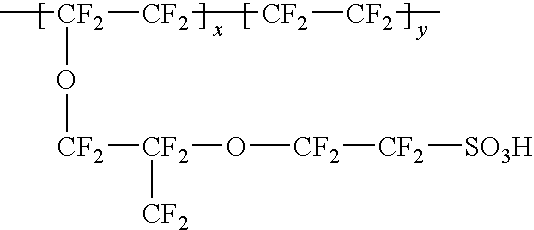Composite solid polymer electrolyte membranes
a solid polymer and electrolyte technology, applied in the field of new materials, can solve the problems of reducing proton conductivity, affecting gas access, swelling of membranes, etc., and achieve the effect of reducing cost and improving performan
- Summary
- Abstract
- Description
- Claims
- Application Information
AI Technical Summary
Benefits of technology
Problems solved by technology
Method used
Image
Examples
example 1
[0247]Sulfonation of Radel R®
[0248]Using Sulfan B® (100% and 150% Stoichiometric Sulfonation)
[0249]Sulfonation Procedure I was used in the following example.
[0250]Two separate 1000 ml 3 neck resin kettles (with ribs) equipped with an N2 inlet, addition funnel, and overhead stirrer were charged with the following reactants: 340 ml of dichloromethane and 50.00 grams of Radel R® Polyphenylsulfone Polymer (beads). These mixtures were stirred until solutions formed (approximately 0.25 hours). Once solutions formed, they were cooled in ice baths to about a temperature of 0° C. (ice bath was maintained throughout the duration of the addition and reaction). (Note that Radel R® was dried at 70° C. under full dynamic vacuum for about 12 hours to remove any adsorbed moisture.)
[0251]While the above solutions were cooling, the following amounts of Sulfan B® were combined with dichloromethane in two separate 125 ml addition funnels. In funnel #1 (100% sulfonation) 10.00 grams of Sulfan B® was com...
example 6
[0319]Sulfonation of Victrex® Poly(Ether Ketone)
[0320]Using H2SO4 / SO3
[0321]Sulfonation Procedure II was used in the following example.
[0322]Procedure:
[0323]30.00 g PEK polymer (Victrex®) was dissolved in 270 g of concentrated sulfuric acid (93.5 wt. %) under nitrogen, stirred by an overhead mechanical stirrer. The polymer was dispersed over several days to form a dark red thick solution.
[0324]176 g of this solution was left in the three neck flask with overhead stirrer, N2, etc. To the flask, 208.4 g of fuming sulfuric acid (25.5 wt. % free SO3) was added over the coarse of a few minutes with constant stirring to raise the solution to a free SO3 content of 2 wt. %. The resulting solution was immersed in a room temperature water bath to control the temperature.
[0325]Samples were removed after approx. 1 hour, 3 hours, and 16 hours, and quenched into deionized water to precipitate.
[0326]In order to make films, the 1 and 3 hour products were washed several times with deionized water, s...
example 7
[0328]Sulfonation of PPS / SO2 Using 97.5% H2SO4
[0329]Sulfonation Procedure II was used in the following example.
[0330]PPS / SO2 provided by James McGrath of VPI [see Synthesis and Characterization of Poly(Phenylene sulfide—sulfone). Polymer Preprints 38 (1), 1997, p.109-112].
[0331]Procedure:
[0332]250 ml 3 neck round bottom flask was equipped with an overhead stirrer, N2 inlet, and addition funnel were charged with 100 grams of 93.5% sulfuric acid. To the rapidly stirring sulfuric acid 25.00 grams of the PPS / SO2 was added. The mixture was stirred at room temperature until a solution formed (approximately 1 hour).
[0333]When solution had formed the temperature was lowered to about 0° C., and 60.0 grams of 23.0% fuming sulfuric acid was added dropwise over a period.of a 0.5 hours.
[0334]Ice bath temperatures were maintained for the first 3.5 hours of the reaction. Aliquots were taken at T=0.5, 1.5, 2.0, and 3.0 hours by precipitation the reaction mixtures were precipitated into deionized w...
PUM
| Property | Measurement | Unit |
|---|---|---|
| temperatures | aaaaa | aaaaa |
| temperatures | aaaaa | aaaaa |
| temperatures | aaaaa | aaaaa |
Abstract
Description
Claims
Application Information
 Login to View More
Login to View More - R&D
- Intellectual Property
- Life Sciences
- Materials
- Tech Scout
- Unparalleled Data Quality
- Higher Quality Content
- 60% Fewer Hallucinations
Browse by: Latest US Patents, China's latest patents, Technical Efficacy Thesaurus, Application Domain, Technology Topic, Popular Technical Reports.
© 2025 PatSnap. All rights reserved.Legal|Privacy policy|Modern Slavery Act Transparency Statement|Sitemap|About US| Contact US: help@patsnap.com



